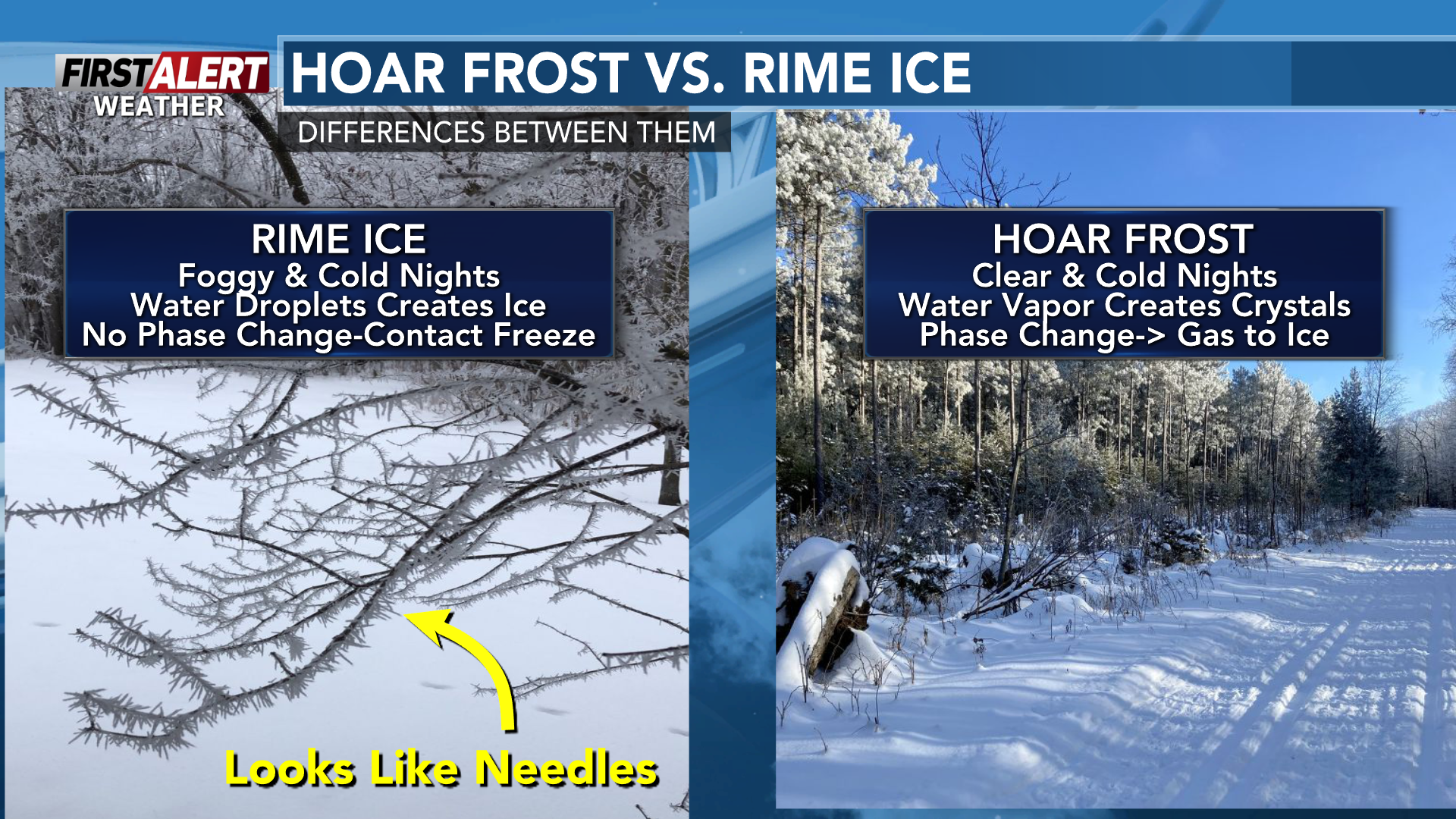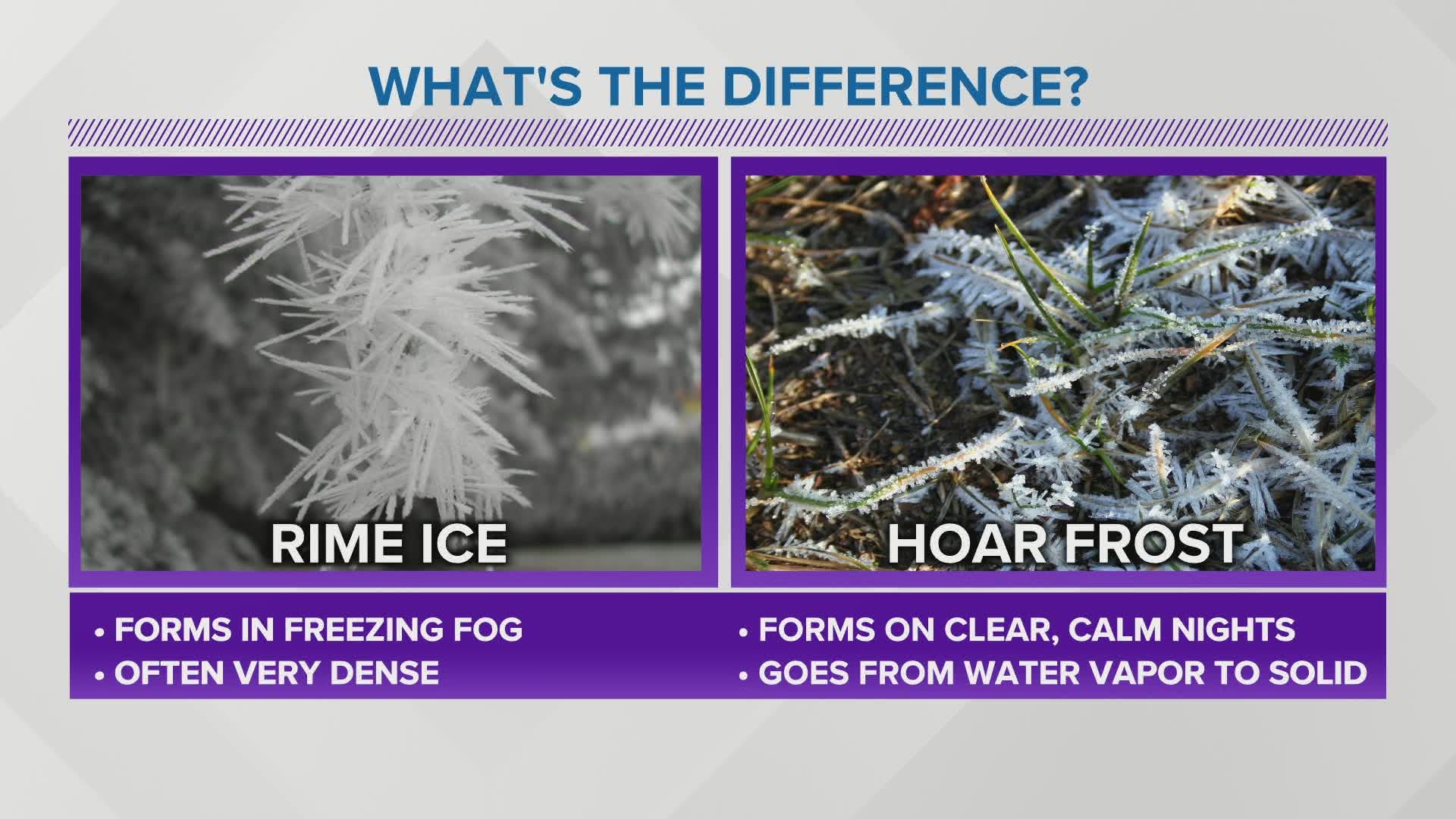What is the Difference between Rime Ice And Hoar Frost: Key Insights
Have you ever woken up to find the world outside your window transformed into a winter wonderland, shimmering with icy details? As you step closer, you might wonder whether you’re looking at rime ice or hoar frost.
These two winter phenomena, while both beautiful, are quite different. Understanding the difference not only satisfies your curiosity but also deepens your appreciation for the intricate designs nature crafts on cold, frosty mornings. We’ll unravel the mysteries of rime ice and hoar frost, giving you the knowledge to impress friends with your newfound expertise.
Ready to discover the secrets behind these icy masterpieces? Let’s dive in!

Credit: www.facebook.com
Rime Ice Formation
Understanding the unique formation of rime ice can be both fascinating and practical. It’s not just a spectacle; it affects your daily life more than you might realize. Imagine waking up to a winter wonderland where every tree branch is elegantly adorned with a frosty glaze. This icy transformation is a result of rime ice formation, a process that occurs under specific weather conditions and has its own distinct characteristics and occurrences. Let’s dive into what makes rime ice so unique.
Weather Conditions
Rime ice formation occurs in cold, foggy conditions where temperatures are below freezing. You might notice it when driving through a dense fog, especially in mountainous areas. As the fog envelops the landscape, tiny droplets of supercooled water freeze upon contact with surfaces. This contrasts with hoar frost, which forms directly from water vapor in clear conditions.
Physical Characteristics
Rime ice has a rough, granular texture, unlike the delicate, feathery appearance of hoar frost. If you’ve ever touched rime ice, you know it feels solid and icy, almost like an outer shell on branches and wires. Its opaque white color can transform a dull landscape into an eye-catching spectacle. This formation often weighs down trees and power lines, sometimes causing damage.
Common Occurrences
Rime ice is frequently seen in high-altitude areas where fog is common, like mountain tops and ridges. If you’re an adventurer or hiker, you might have encountered it during a winter trek. It also appears in places with frequent fog, such as coastal areas. Have you ever wondered why some areas get more rime ice than others? It’s all about the interplay between fog and freezing temperatures.
Understanding rime ice can enhance your appreciation of winter’s beauty and prepare you for its challenges. Next time you see those icy sculptures, pause and consider the unique conditions that created them. How do these icy formations impact your winter activities or even your daily commute? Share your thoughts and experiences below!

Credit: www.wsaw.com
Hoar Frost Formation
Hoar frost forms when water vapor turns directly into ice on cold surfaces. It’s delicate, feathery, and white. Rime ice, however, occurs when supercooled water droplets freeze on contact, creating a rough, opaque coating. Both are stunning, but differ in their formation processes and appearance.
Hoar Frost Formation Hoar frost is a stunning natural phenomenon that transforms landscapes into a winter wonderland. It’s a type of frost that forms on cold, clear nights when air temperatures drop below freezing. Unlike snow, hoar frost appears as delicate, white ice crystals that blanket surfaces like trees, grass, and fences. Let’s dive into how weather conditions, physical characteristics, and common occurrences contribute to its enchanting formation.Weather Conditions
Hoar frost requires specific weather conditions to form. You need clear skies and calm winds for the magic to happen. When the air is still, it allows moisture to settle without disturbance. Cold temperatures are essential, but the key is how the moisture in the air cools rapidly and deposits directly onto surfaces. Have you ever noticed how peaceful and quiet the world feels during a frosty morning? That’s the perfect setting for hoar frost.Physical Characteristics
The beauty of hoar frost lies in its intricate patterns. It forms needle-like crystals that grow outward from surfaces. These crystals can be so thin and delicate that they look like a dusting of powdered sugar. Hoar frost is not dense like ice; instead, it’s light and airy. If you touch it, it often crumbles easily. You might notice how it sparkles in the sunlight, adding a magical touch to your morning walk.Common Occurrences
Hoar frost is most commonly seen in rural areas, where open fields and vegetation provide ample surfaces for frost to form. It’s a frequent visitor in valleys and near bodies of water where humidity is higher. You may spot hoar frost more often during the colder months, especially when the nights are longest. It’s a reminder of nature’s quiet artistry, turning everyday scenes into a breathtaking sight. Have you ever paused to admire the hoar frost on a chilly morning? It’s these moments that make winter special. Understanding hoar frost can deepen your appreciation for the subtle beauty of winter. Next time you see it, take a moment to enjoy its delicate charm and consider the perfect blend of weather conditions that brought it to life.Visual Differences
Rime ice and hoar frost might seem similar. Yet, they have distinct visual differences. These differences can be seen in their texture and color. Understanding these can help identify each one easily.
Texture And Appearance
Rime ice has a rough texture. It forms when supercooled water droplets freeze on surfaces. These droplets create a crusty layer. Often, it appears spiky or feathery. This gives it a unique look.
In contrast, hoar frost appears soft and delicate. It forms directly from water vapor. The vapor turns into ice crystals on surfaces. This makes hoar frost look like white, feathery layers. It resembles fine, needle-like structures.
Color And Transparency
Rime ice usually appears white or opaque. The trapped air bubbles give it this color. This makes it less transparent than other ice types. Its dense structure scatters light.
Hoar frost, on the other hand, is more transparent. It has a clear, crystalline appearance. The ice crystals are thin and light. This allows more light to pass through. It often sparkles in sunlight, adding to its beauty.
Impact On Environment
Understanding the difference between rime ice and hoar frost is crucial when considering their environmental impacts. These two phenomena, though seemingly similar, have distinct effects on both vegetation and infrastructure. Have you ever wondered how a winter wonderland can turn into an environmental challenge? Let’s delve into the specifics.
Effects On Vegetation
Rime ice, formed when supercooled water droplets freeze upon contact with surfaces, can weigh down branches. This added weight can break limbs and cause long-term damage to trees and plants. Imagine walking through a forest after a rime ice event—what used to be a vibrant canopy might now be a scene of broken branches and disrupted habitats.
Hoar frost, on the other hand, forms through direct freezing of water vapor, creating a delicate layer on surfaces. While beautiful, it can impact the photosynthesis process of plants by blocking sunlight. A frosty morning might look magical, but how does it affect your garden’s growth? Does it leave plants gasping for light?
Influence On Infrastructure
Rime ice can accumulate on power lines, causing outages. The weight can strain infrastructure, leading to costly repairs and maintenance. Have you ever experienced a power outage during winter? It might have been caused by rime ice’s relentless grip on the lines.
Hoar frost, while less aggressive, can create slippery surfaces. Roads, bridges, and walkways become hazardous, increasing the risk of accidents. Next time you spot a frosty sidewalk, consider its impact on your morning commute. How prepared are you for the unexpected slip?
Both rime ice and hoar frost pose unique challenges. They require different strategies to manage their effects on the environment. By understanding their differences, you can better prepare for and mitigate the impacts they have on your surroundings.
Safety Implications
Safety Implications:
Understanding the difference between rime ice and hoar frost isn’t just about weather trivia. It can impact your safety in profound ways. These ice formations, despite their beauty, can pose risks in various aspects of daily life. From traveling to outdoor activities, being aware of these risks can help you make safer choices.
Travel And Transportation
Rime ice can form quickly on road surfaces and power lines. It creates a slick layer that may surprise drivers. Imagine you’re driving on what appears to be a clear road, only to find your car sliding unpredictably. This is a common danger with rime ice.
Hoar frost, while less slippery than rime ice, can still affect visibility. It often accumulates on windshields and mirrors, obstructing your view. This can lead to accidents if you’re not prepared to clear it off before driving.
Have you ever thought about the impact on public transportation? Buses and trains can also face delays. Rime ice on tracks can cause major disruptions. Your morning commute might turn into a waiting game, testing your patience.
Outdoor Activities
Rime ice can be a hazard for hikers and climbers. It forms as a heavy coating on trees and rocks, making surfaces unexpectedly slippery. Imagine reaching for a tree branch for support, only to find it covered in ice. This can lead to falls and injuries.
Hoar frost, though not as heavy, can still affect outdoor gear. It can accumulate on ropes and tents, reducing their effectiveness. If you’re camping, you’ll need to be vigilant about clearing frost off your equipment to maintain safety.
Are you planning a winter hike or camping trip? Consider the weather forecast carefully. Even a small change can lead to dangerous conditions with rime ice or hoar frost. Preparation is key to ensuring your adventure is both fun and safe.
Understanding these ice formations can make all the difference in your safety. Whether you’re driving to work or exploring the great outdoors, knowledge empowers you. Are you ready to take on the challenge of winter weather with confidence?
Scientific Significance
Rime ice and hoar frost are fascinating natural phenomena. Both occur under specific atmospheric conditions. Their scientific significance lies in their formation processes. These processes provide insights into weather patterns. They also offer clues about climate changes. Understanding these phenomena helps meteorologists and climatologists in their research.
Meteorological Studies
Rime ice forms in cold, foggy conditions. Supercooled water droplets freeze on contact with surfaces. This process interests meteorologists who study weather patterns. It helps them predict weather-related events. Hoar frost, on the other hand, forms on clear, cold nights. It results from water vapor turning directly into ice crystals. Studying hoar frost aids in understanding atmospheric humidity levels. Both phenomena offer valuable data for meteorological studies.
Climate Indicators
Rime ice and hoar frost can indicate climate trends. They reflect changes in temperature and humidity. Consistent patterns in their formation may suggest climate shifts. Scientists observe these patterns to assess environmental changes. Rime ice might signal increased foggy conditions. Hoar frost could indicate colder, clearer nights. Both serve as important climate indicators.
Cultural And Aesthetic Value
Rime ice and hoar frost are not just weather phenomena. They hold cultural and aesthetic significance. Their beauty and mystery have inspired stories and art. These natural wonders captivate people across the world.
Folklore And Traditions
Many cultures have tales about ice and frost. Rime ice is often linked with mythical creatures. Some believe it forms from spirits or magic. Hoar frost has its own legends. In some tales, it is the breath of winter spirits. These stories have been passed down for generations.
Traditions also celebrate these icy formations. In colder regions, festivals occur during frost-covered days. Communities gather to admire the sparkling landscapes. These events bring people together in appreciation.
Photography And Art
Rime ice and hoar frost create stunning visuals. Photographers travel far to capture their beauty. The intricate patterns of hoar frost are a favorite subject. Rime ice, with its unique shapes, intrigues artists. They find inspiration in its delicate designs.
Paintings and sculptures often depict these icy wonders. Artists use them to convey serenity and wonder. The fleeting nature of these formations adds depth to their work. Both rime ice and hoar frost continue to inspire creativity.

Credit: www.youtube.com
Frequently Asked Questions
What Causes Rime Ice To Form?
Rime ice forms when supercooled water droplets freeze on contact with surfaces. It typically occurs in foggy or windy conditions. The droplets freeze rapidly, creating a white, opaque ice layer. It is common on trees, wires, and other exposed surfaces in cold, moist environments.
How Does Hoar Frost Develop?
Hoar frost develops when water vapor in the air sublimates directly onto cold surfaces. It forms under clear, calm conditions. The ice crystals are delicate and feathery, often creating beautiful patterns. Hoar frost is common on grass, leaves, and other exposed surfaces during cold, clear nights.
Are Rime Ice And Hoar Frost Dangerous?
Rime ice can be dangerous, especially when it accumulates on power lines or aircraft surfaces. It adds weight and can cause structural damage. Hoar frost is generally not dangerous but can create slippery surfaces. Both phenomena should be approached with caution in affected areas.
Can Rime Ice And Hoar Frost Occur Together?
Yes, rime ice and hoar frost can occur together under certain conditions. This happens when both supercooled water droplets and sublimating water vapor are present. The combination creates unique and complex ice formations. Observing both requires specific atmospheric conditions, making it a rare but fascinating occurrence.
Conclusion
Rime ice and hoar frost both form in cold conditions. Yet, they differ. Rime ice forms with supercooled water droplets. Hoar frost forms from water vapor turning into ice. Rime ice appears harder and denser. Hoar frost looks like delicate white crystals.
Both are beautiful, but unique in their creation. Understanding these differences helps appreciate winter’s wonders. Next time you see them, you’ll know what makes each special. Enjoy the beauty of nature’s icy creations. Stay curious and keep exploring the marvels of the natural world.







